Abstract
The waste-to-energy programs that have taken place in recent years present a daunting picture in terms of sustainable material management. The incineration of much organic and unorganized waste in metropolitan waste treatment facilities is not meet with sustainable development. The solution to this problem may be to increase urban composting programs in the future, which is a sustainable treatment option but also a serious technical challenge. Our research question is whether composting programs can play a key role in rapidly evolving urban ecosystems in Asia, due to the specificities associated with the waste rates outlined and developmental differences outlined. Instead of the waste-to-energy or waste-to-landfill strategies often used today, can central composting focusing on high organic matter content be a suitable alternative? Using the AHP method (Analytical Hierarchy Process), the following alternatives were examined to clarify the issue: Wastes are commingled and processed at the treatment facilities; Classification of organic and non-organic waste at source for composting; Totally separating waste at source before processing at the treatment facilities. We have found that the use of central composting (separation of organic and non-organic waste at source) strategies to support circular development is one of the most innovative development strategies in the fast-growing cities of Asia, in line with E.U. targets.
1. Introduction
Regarding the effects of urbanization and healthy food consumption, we often hear about centralized composting, which can mean ensuring nutrient cycling when planning for the sustainable development of urban ecosystems. The question, in this case, is why composting may be important for municipal waste management. It has become one of the most pressing global issues due to the large amount of organic waste produced in the environment. Biological processes for rotting organic wastes are considered a more appropriate alternative than landfill and incineration among the different therapies for treating organic waste [1,2]. Composting is an aerobic mechanism in which microorganisms degrade and convert complex degradable materials into organic and inorganic byproducts [3,4]. Temperature, moisture content, aeration, pH, and C: N ratio are all physical-chemical parameters influenced by this phase [5]. Composting is a solid waste management system (SWM) that allows organic waste to be recycled into valuable items. It can also be used to limit the accumulation of waste [6]. This method is environmentally friendly, agronomically sound, and effective, as compost can be used as a fertilizer, soil conditioner, organic, and source of high nutrients for the soil [7,8,9,10]. The microbial population can also stabilize the degradable organic matter in compost, bacteria, fungi, and worms. Aside from that, the microbial population’s characteristics are influenced by the substrate and physical conditions of composting, such as temperature, moisture, and aeration. Since composting is only suitable for biodegradable waste, the efficiency of the composting method will also be determined by the waste characteristics [11]. As a result, the separation of organic and inorganic waste prior to treatment would be critical to the effectiveness of composting.
The waste composition varies according to income class, indicating different consumption trends. High-income countries produce small quantity green and food waste, accounting for 32% of total waste, and more solid waste that can be recycled, such as cardboard, metal, plastic, paper, and glass, accounting for 51% of total waste. Food and green waste are produced in 53% and 56% of middle- and low-income countries, respectively, with the proportion of organic waste rising as economic growth declines. In low-income nations, recyclable materials account for 16 percent of waste [12]. Organic waste accounts for the bulk of urban waste in middle and low-income countries, and most Asia-Pacific countries fall into this group [13]. Because of a lack of regulations and public participation, there is no Municipal Solid Waste (MSW) separation at the household level in Bangkok; thus, the MSW produced contains more organic waste, resulting in lower MSW calorific value compared to other developed countries [14]. More than 90% of the MSW produced is disposed of in an unscientific and unacceptable manner on property in India. Chemical waste makes up a large percentage of urban solid waste (70–75%) [15]. The physical and chemical properties of the organic fraction of waste are altered for energy and resource recovery.
Composting (aerobic treatment) or bio-methanation (anaerobic treatment) are the two most important disposal techniques [16]. Composting provides a stable commodity called compost, which can be used as manure or a soil conditioner. Compost plants in metropolitan cities are underutilized for a variety of reasons, the most important of which are unsorted waste and the development of low-quality compost, resulting in lower demand from end-users [17]. MSW is produced at a rate of 1 Mt/day in Asian countries, with the waste generation rate expected to hit 1.8 Mt/day by 2025 [4,18]. The organic fraction in MSW produced in Asia’s developing countries is enormous, accounting for more than half of the total MSW composition [19]. Organic levels are generally in line with expectations, with 24–34 percent (average 28 percent) recorded in five European, North American, and Australian cities with Varna, Bulgaria, and 13 of the 15 ‘Southern’ low and middle-income countries (average 67 percent). This is due to a lower intake of seasonal fresh fruits and vegetables, and a greater frequency of packaging coupled with other consumer goods that result in a stream of waste in high-income countries. Since the data is not widely available, it is challenging to report moisture content, waste density, or heating values. In comparison to comparatively light waste with low organic content in high-income or European countries, the high organic substance in low and middle-income cities typically means very high moisture content, dense waste, and decreased heating values. These disparities alone pose the fundamental question of whether such new waste management technologies built in the ‘North’ over the last 40 years are suitable for export to the rest of the world. In several developing countries, compactor trucks built for light ‘Northern’ waste with substantial large packaging materials are both wasteful and unacceptable. The high organic material means that valorizing (organic waste recovery) could be considered a technology based on baseline rather than landfill disposal. The thermal treatment of unprocessed MSW, which would require additional fuel to sustain combustion, should be avoided due to the high tropical rainfall and high organic content, enhancing the moisture content even further [20,21]. The purpose of this study is to investigate the current status of solid waste management technology and system in Ho Chi Minh City, Vietnam. Based on that, the authors suggest sustainable municipal solid waste management strategies and scenarios to minimize the negative environmental impacts of inappropriate solid waste management. Our research question is whether composting programs can play a key role in rapidly evolving urban ecosystems in Asia, due to the specificities associated with the waste rates and developmental differences outlined. Instead of the waste-to-energy or waste-to-landfill strategies often used today, can central composting focusing on high organic matter content be a suitable alternative?
The rest of this paper is organized as follows. Section 2 focuses on the reasons for applying the AHP method found in relevant scientific papers in similar situations and the special characteristics of waste in Ho Chi Minh City (HCMC). Section 3 describes the methodology. Section 4 presents the results and Section 5 a discussion of the achieved results. Section 6 draws the main conclusions and points out the future work.
2. Literature Review
Solving research problems basically depends on finding a way to compare possible waste management alternatives and the indicators used in them according to their importance. Several scientific works in the literature have already used the AHP method to select the best alternative, which is summarized below. Through the example of one of the fastest-growing cities in Vietnam (Ho Chi Minh City), we would like to show what alternatives to waste management the city can choose by exploring possible technological applications. According to our review, the application of short- and long-term strategies can induce completely different solutions. This is also supported by our AHP analysis.
The concept of a master plan for solid waste management in hospitals is proposed, considering various criteria that are commonly used to assess the contamination caused by loading solid waste of hospitals. The management schemes’ efficacy is also assessed in Khuzestan, Iran. A multiple criteria decision-making methodology known as the analytical hierarchy process (AHP) is used to rank the hospitals and assess each hospital’s share of the overall loading pollution of hospital solid waste [22]. The most favored landfill siting option was defined using the AHP). The relative simplicity of managing various parameters, simple interpretation, and efficient handling of both qualitative and quantitative data are the key advantages of AHP. This model was found to be ideal for landfill siting because it was able to monitor the precision of the operations by field observations in Karaj, Iran [23]. Integrated lean and green paradigms positively affect a company’s efficiency and productivity in Indian SMEs. To overcome the business challenges faced by SMEs, the AHP ensures that total efficient maintenance is recognized as the most relevant lean practice. In contrast, ISO 14,001 is the most effective green practice [24].
In poor management and high costs, waste from oil and gas well drilling operations may cause environmental issues. Choosing an appropriate model of waste management in various industries is critical to an area’s long-term development. Given the significance of the gas and oil industry question, it is important to devise an appropriate procedure in this regard. AHP can be an effective technique for Iran in collecting, transporting, and recycling drilling waste in an oil company [25]. One of the long-term consequences of drilling gas and oil mines is the generation of waste in Malaysia [26]. The existence of oily substances in the waste may have negative environmental consequences. As a result, implementing an effective waste management strategy is essential in Egypt [27]. In an AHP model, gasification is indicated as the selected technology because it eliminates requirement dependencies while prioritizing net production and retention time. The hierarchical analytical network process (HANP) is a good structure for proposing which technologies to follow in India. When major infrastructure projects are being done, the use of such resources is important [28].
For health care waste management (HCWM) schemes, the AHP is a useful tool. In developed countries, it can be improved. According to the risks of infection related to the life cycle portion choices available to decision-makers in the life cycle of waste, the AHP was used to assign priorities to the alternatives in the life cycle of waste. Alternatives or combinations of opportunities for essential elements of an HCWM framework were rated according to the corresponding collective risks for best practices in the context of that developing country [29]. The outcomes of the AHP application indicate that among the stakeholder groups, landfill capacity and greenhouse gas (GHG) emissions constraints are rated higher than the expense connected with the plan’s implementation and health damage linked with the treatment plans proposed in Boston, USA [30]. The AHP methodology was used to structure and evaluate stakeholders’ opinions and decisions on the environmental impacts of solid waste disposal. The most important environmental effects include flora and fauna, habitat degradation, and land use. The environmental impacts of landfilling, recycling, incineration, and composting were assessed in Johor Bahru, Malaysia [31]. Designing for recycling has been a major issue for businesses, and it has proven to be difficult to enforce. The explanation for this is that most designers are unable to assess the rate of product recycling because design time is limited. AHP aids in resource conservation in Taiwan. The vital components that cannot be easily recycled can be easily reprocessed in the early design stages using the AHP technique [32]. In Iran, biogas technology based on AHP is the first option for biomass energy generation. This technology is one of the cleanest innovations for replacing fossil fuels due to its environmental benefits. In contrast to other innovations, biogas has a lower impact on air quality. Another benefit of this technology is its scalability when it comes to using decentralized biomass resources [33].
Using the fuzzy analytical hierarchy process (FAHP), multiple factors such as infrastructure, geology, and social and environmental factors are used to calculate global priority weights (FAHP). The proposed model’s main benefits are that it can help with the multi-criteria facility location issue by guiding the selection of a new suitable location based on quantitative and qualitative factors (Wichapa). The combination of GIS and the AHP model can be a powerful tool for determining the best waste disposal site [34]. AHP is a complex method for locating hazardous waste landfills in vast areas. As a realistic solution, this method considers resource availability in the Qazvin province of Iran [35]. The use of both the GIS and the AHP together can aid decision-makers in making quick assessments and, as a result, solving any issue, such as landfill site selection in Al-Hillah Qadhaa in Iraq [36]. Concerning the chosen parameters, the AHP approach can be used to select the most sustainable energy recovery from the Municipal solid waste (MSW) alternative in Tehran, Iran [37]. The AHP technique confirms that environmental regulation is critical for developing policy initiatives in the United States [38]. Environmentally sustainable product design and production have become an important part of business policy in recent years. The AHP decision model aids the decision-making process for ISO 14,001 EMS (Environmental Management System) adoption by objectively assessing the applicable requirements and logically assisting the decision-making process. The AHP method may be used by evaluators or managers from various organizations in Hong Kong to decide the objectives among decision criteria and benefits and assess the efficacy of their EMS adoption [39]. The co-combustion method is the most favorable, followed by the animal feed option, and disposal without treatment is the least favorable, according to the AHP model performance. The proposed analytical hierarchy process model’s sensitivity was discussed because the goals in Jordan’s olive mill solid waste management alternative may change in Jordan [40]. MSW is a global issue that affects both developed and emerging cities. Municipal solid waste can be a source of various pollutants in water, air, and soil if it is not properly handled. While landfills are at the bottom of the priority list for urban solid waste management techniques, their importance in emerging economies cannot be overlooked. The selection of a landfill site is a challenging puzzle involving political, social, economic, and environmental factors. The regional screening was conducted using a GIS and AHP system to identify potential landfill sites, and six areas in Makkah were found. By 2020, the existing MSW dumping site will be closed. If the Kingdom of Saudi Arabia moves closer to achieving Vision 2030, AHP should be implemented [41]. Inadequate training programs have emerged as a significant impediment to the proper execution of the AHP model waste management technique in any manufacturing facility. Aside from that, a lack of understanding of waste management strategies is also a major problem in the application of techniques of waste management. Manufacturing companies in India are having problems with the compatibility of various waste management technologies and techniques [42]. We encounter a similar problem to be solved in the case of Ho Chi Minh City, the details of which are discussed below.
Most of the current research concludes that “waste to energy” is the most appropriate solution. However, this is not in line with the principles of circular economy in many cases and cannot solve waste management problems in a short way. Evaporation of high moisture content in many cases is not energy positive but on the contrary, it requires energy.
3. Materials and Methods
3.1. Composition of Waste in Ho Chi Minh City (HCMC)
HCMC is the hub of Vietnam’s largest metropolitan area, which is expected to grow to 12 million people by 2025, including semi-urban areas [43]. This is a megacity and the country’s economic hub. There are 2095 square kilometers in the administrative district. About 8.2 million people live in the city’s entire territory, with an average population density of 3400 people per km2 [44]. The quantity of municipal solid waste (MSW) produced in HCMC is steadily increasing, and municipal waste accounts for most of the generated solid waste. The total amount of municipal solid waste produced each day is estimated to be between 7200 and 7800 tons (excluding waste sludge). Due to urban expansion and growth, the municipal solid waste generation rate in HCMC increased from 10% to 15% [45,46,47], which is higher than in other parts of Vietnam (8–10 percent). The composition and development of urban waste vary depending on various factors, including lifestyle, income, season, cultural activities, and place. In the HCMC waste management (W.M.) system [48], there are also material recovery facilities; the overall system is structured linearly, with a portion of waste flows ending up in landfills to many other cities in developing countries. Even though the regulatory structure aims to create a circular economy in Vietnam and set collection and recycling goals, HCMC faces significant challenges. According to the waste profile, organic matter, which accounts for 65 percent of total MSW, is the most prevalent portion of municipal solid waste. Around 25% of urban solid waste, such as plastic, paper, and metal, is recyclable. At a rate of 0.12 percent, hazardous waste is incorporated with municipal waste. The Phuoc Hiep and Da Phuoc complex was designed to handle solid waste in the HCMC region to control the waste stream. It consists of multiple landfills and a composting plant that can handle 700 tons of waste every day [49]. In the case of Ho Chi Minh City, there is a high volume of organic matter in municipal solid waste, which, through a well-managed separation program, can end up in central composters that manage material flows in a sustainable way and avoid landfills or waste incineration systems.
3.2. Application of the Analytical Hierarchy Process (AHP) Methodology
In this section, the methodology for the assessment of the MSW management alternatives (scenarios) is explained. Eventually, using the analytical hierarchy process (AHP) methodology, the assessment of three alternatives is investigated.
The AHP method was used in our research. Person priority levels can be compared using the pair-wise comparison approach based on the chosen and selected parameters. In the water management market, the AHP approach may be used to analyze and compare various business model solutions. The analytical hierarchy (AHP) is introduced by Saaty [50,51,52,53,54] to aid multi-criteria decision-making, in which [55]:
- The issue is broken down into its constituent parts, according to the study.
- Hierarchy denotes a relationship between the mentioned components and the primary target.
- Method denotes the processing of data and decisions to obtain the desired result.
AHP has two stages: (i) identifying hierarchical trees and (ii) in terms of numbers, evaluating the trees. Identifying the proposed goal is the first step in creating a hierarchical tree. The experts’ experience determines the parameters and sub-criteria; finally, the alternatives are a priori reflecting the tree’s leaves. A pair-wise comparison is used in the evaluation stage. The relative weights of the standards on the same level of the hierarchy are contrasted to the father-level standards. This procedure helps you to arrive at values that balance the requirements and (ii) rate the alternatives. The decision-making process starts with a comparison of the choices to the criteria of the final stage. The assessment then moves on to the requirements of the first level before being compared to the target. The following scale (Table 1) is used to articulate the intensity of significance for each indicator:

Table 1.
Saaty’s fundamental scale [51].
The AHP model’s hierarchical structure makes it simple for decision-makers to understand problems in terms of applicable criteria and sub-criteria. Other standards can be added to the hierarchy to allow for further comparison. Finally, sensitivity analyses may be used to investigate the effects of changing a criterion’s weight. With sensitivity analysis, the solution’s robustness can be determined, and (ii) parameters can be defined that are more relevant to the final outcome. This model will help prioritize and provide optimal solutions based on this knowledge if these measures are followed. This approach is often used to address complex decision-making problems in a variety of fields, including environmental protection, manufacturing, waste management, power, transportation, electricity, and construction [56]. In waste management, the AHP approach is commonly used in Bosnia and Herzegovina to determine and pick solid waste management strategies [57]. To determine the best management approach, solid waste management [58], and to assess the policy consequences of solid waste management decision-making [59]. This approach is also used to evaluate solid waste treatment or rank appropriate solid waste facility sites [28,60]. AHP is effective to compare and contrast various waste management plans in Boston, Massachusetts [30]. The Super Decision Software was created by the Creative Decisions Foundation, which was established in 1996 by Thomas L. Saaty, to make AHP calculations easier. This is a plain, easy-to-use package for creating decision models with dependencies, input, and computing results using the Analytic Hierarchy Method’s supermatrices.
3.3. Application of the Analytical Hierarchy Process (AHP) and Super Decision Software to Choose a Sustainable Scenario for Municipal Solid Waste Management in HCM City
Criteria are defined to evaluate three alternatives explained below. These criteria are listed in Table 2.

Table 2.
Criteria and Sub-Criteria used in AHP.
This research conducted an expert-roundtable. The expert-roundtable included two Vietnamese Ph.D. researchers with significant experience in transition management process analysis and waste management. Two experienced lead researchers of the Climate Change Economics Research Center, who have AHP practice and publications, regulatory issues, and waste management background. Two additional experts from the waste markets. All the six experts have knowledge of waste and energy management in developing countries. During the AHP, the protocol provided by the Super Decisions Software was followed, and the result was sent to specialists for confirmation. This result included the pair-wise comparisons, in which the participants had to match the criteria and sub-criteria and alternatives in pairs to assess their preferred choice. The details for pair-wise comparison are presented in Appendix A (Figure A1, Figure A2, Figure A3, Figure A4, Figure A5, Figure A6, Figure A7, Figure A8, Figure A9, Figure A10, Figure A11, Figure A12, Figure A13, Figure A14, Figure A15 and Figure A16).
The structure of AHP analysis for sustainable municipal solid waste (MSW) management in Ho Chi Minh City using the Super Decisions Software is described in Figure 1.
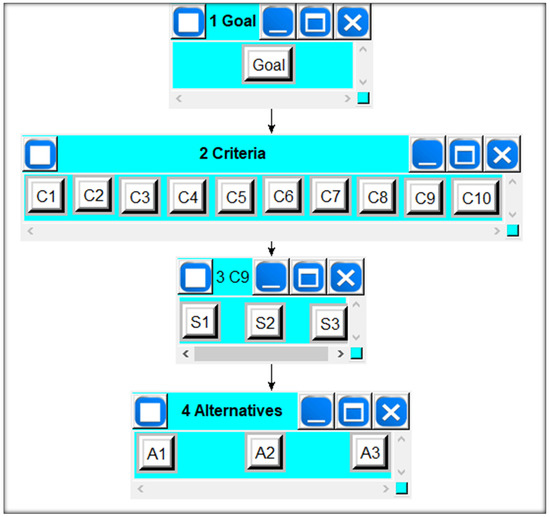
Figure 1.
Structure of AHP analysis for sustainable municipal solid waste (MSW) management in Ho Chi Minh City (Source: by authors).
The AHP method has recently become very popular and widespread is the type where it is based on hundreds of questionnaires. However, the original idea is that this is a subjective expert method, where a team develops the criteria system and possible alternatives. Although this is a subjective method, it is very suitable for identifying directions for development.
The goal of the AHP was to choose the best scenario for sustainable MSW management in the situation of Ho Chi Minh city.
Based on the online questionnaires that were sent to the experts, they make the paired comparison matrices to determine the weights of the decision task and evaluate the alternatives (in this case: A1, A2, A3) for each leaf criteria (C1: C10) and sub-criteria (S1, S2, S3).
During the process, three relevant alternatives were given.
A1: Wastes are commingled and processed at the treatment facilities.
A2: Classifying organic and non-organic waste at source for composting.
A3: Totally separating waste at source before processing at the treatment facilities.
4. Results
According to the AHP analysis, the required alternative for the MSW management in the case of Ho Chi Minh city regarding the pre-set criteria, is the separation of organic (degradable) and non-organic waste at source and composting the degradable parts (Figure 2).
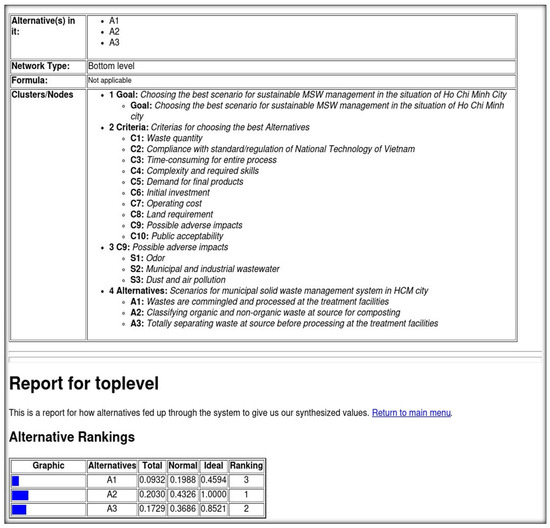
Figure 2.
The structure of the AHP analysis and the order of the alternatives (Source: original result table from the Super Decisions Software, edited by authors).
The other alternatives lagged behind because of different reasons. Multi-criteria decision analysis (MCDA) is a method which examines economic, social, and environmental criteria [61] altogether, while other methods focuses only one aspects like cost–effectiveness or environmental impacts.
According to these the main criteria were the public acceptability (C10) which was significantly higher than the others and followed by the possible adverse impacts (environmental impacts; C9). The economic factors also had a great influence on the final alternative (Figure 3). It is also important to note that the initial investment has a greater impact than the operating costs.
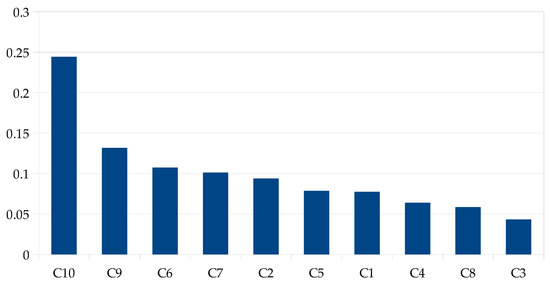
Figure 3.
The most important influencing factor with respect to the goal, (Source: results from the Super Decisions Software).
Complexity, time consumption of the process and the land requirements are the least influencing in this case.
Further investigation of the most important criteria also provides interesting results. The most favorable alternative with respect to public acceptance is the separation of the organic fraction (Figure 4).
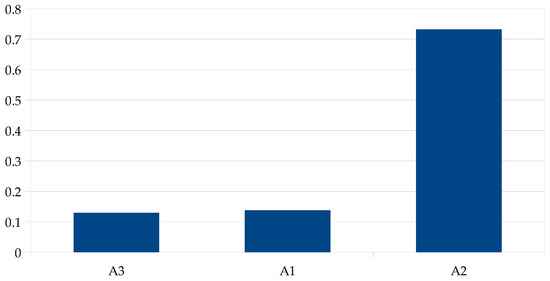
Figure 4.
The most favorable alternative with respect to “Public acceptance” (C10) (Source: results from the Super Decisions Software).
The social acceptance is the greatest in the case of organic fraction separation. Dividing the waste into two fractions does not require special knowledge or training. Mitigation of the adverse effects of climate change and sustainable development are areas which are important for the broad sections of society.
The second most influential criterion was adverse environmental effects, which could be further divided into sub-criteria (Figure 5).
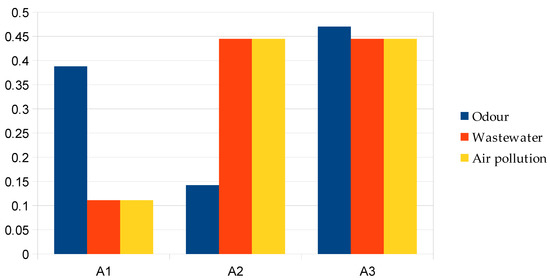
Figure 5.
The most favourable alternatives with respect to odour, quantity of wastewater and air pollution (Source: results from the Super Decisions Software).
In terms of odor, the worst alternative would be organic separation, while full selection would be the most favorable.
The largest amount of wastewater would be in the case of waste treatment facilities, while there is no difference in the other two alternatives.
Dust and air pollution are also the worst in the case of waste treatment, while there are no differences between the other two alternatives in these respects.
For the initial investment, full segregation would also be the most appropriate, followed by organic segregation.
In terms of operating costs, there is no difference between the full and two-way selection (organic and non-organic), while the less favourable is the handling in waste management facility.
It is clear from the results that alternative A2 is the most appropriate in terms of the more important criteria. However, the A3 alternative are the best solution from the environmental aspects.
5. Discussion
Considering that composting by using the organic fraction of municipal solid waste (OFMSW) is an attractive and inexpensive method, it was introduced as one of the suitable methods that can augment the organic amount of soil and maintain the environment [62]. Composting provides the recycling of nutrients and, as a result, reuse of OFMSW, thus reducing environmental pollution caused by dumping waste in nature. Due to the easiness and speed of composting technologies, and their uncomplicated implementation, it is a viable alternative for the management of MSW in developing countries. Besides, composting has lower costs for startup and maintenance compared to other options [63].
The results show the main criteria are C6, C7 (investment and operating costs), C9 (possible side effects) and C10 (social acceptance) in AHP. The A2 alternative was much better than the others in case of this latter criteria. It can be explained that composting can have a significant role in sustainable agriculture, and it is an important element of the circular economy, as mentioned above.
The basis for the selection of the criteria was the fact that the MSW management is a complicated and multi-dimensional issue [64]. MSW management addresses a number of factors, such as, among others, the political and legal framework, financial management, public participation, and awareness [65,66]. Besides these, the multi-criteria decision analysis (MCDA) examines economic, social, and environmental criteria [61]. So the model based on MCDA–the AHP (analytic hierarchy process) contains relating criteria [67].
Alternative A3 was just lagging behind A2, while alternative A1 was the least favorable. In most countries, municipal solid waste (MSW) is treated mainly via landfill and incineration [68,69]. Incinerators were originally used to reduce the volume and protect humans and the environment from hazardous waste, but not to recover energy [70]. For example, in India, incineration techniques are not very prevalent, owing to the presence of high moisture content (40–60%), high non-active material (30–50%), low CV value (800–1100 kcal/kg), and high organic material (40–60%) [71]. These parameters make it much more expensive to incinerate waste in other developing countries as well.
The effectiveness of source-point waste classification cannot always be guaranteed, especially in developing countries [72]. There are many different types of waste mixed together with organic waste, which makes it difficult to ensure stable operating conditions of organic waste treatment technologies such as anaerobic digestion. So the other type of the biological stabilization of organic matter via composting can be a good solution [73].
Composting technology is the most common and cost-effective technique to treat the organic fraction of municipal solid waste [27]. It is the best technology for the organic fraction of biodegradable MSW, which includes dairy waste, vegetable waste, food waste, and slaughterhouse waste [74]. Composting is a preferred solution as compared to another type of treatment because of the budgetary limitations. Income levels and waste volumes are not increasing at the same rate, and therefore the population is unlikely to be able to cover the costs of waste management [67].
The development of waste to the energy sector has been vulnerable to many technological, political, and economic barriers such as lack of funding, incomplete data collection and analysis, inconsistent policies, and regulations [74].
The A3 alternative can gain importance in the future in developing countries, which process is strengthened by that it is no longer possible to export selective waste from Europe to China. This puts significant demand pressure on markets outside Europe. However, this kind of treatment supposes a sophisticated selection methodology. In countries where this is mandatory, many households fear that they will not be able to sort waste properly. Adequate education of the citizens is needed in this case which can take a longer time. Although many cities have initiated successful projects regarding sustainable development [75]. This helps to reduce the amount of waste going to landfills [76] and can serve as a good example of the efficient use of selective ignition systems [77].
The question can be emerging whether the anaerobic digestion (A.D.) and the biogas plant are not mentioned among the alternatives. Besides the abovementioned problem of the excessively mixed waste, the water consumption of a biogas plant must be ensured, whether from livestock (slurry) or from other sources, is a very serious limiting factor in most developing countries. On the negative side, the raw material demand of the biogas plant is continuous, which is an intensive production system pressure towards the use of organic matter. Biomass is only produced to meet this demand of organic matter for biogas plants.
6. Conclusions
The metropolitan area of HCMC is greater than Hanoi, the capital city of Viet Nam. It is the most populous city of Viet Nam with a population of 8.2 million people. High levels of urbanization and the increasing population have put tremendous pressure on the infrastructure system, including the municipal solid waste management system. Current technologies and strategies for municipal solid waste management in HCMC are outdated, and most of the unsorted municipal wastes are being treated by incinerating or landfilling. This has led to adverse environmental impacts on air, soil, and water. Therefore, HCMC has a strong need to select and apply sustainable municipal solid waste management strategies and scenarios to minimize the negative environmental impacts of inappropriate solid waste management. The process of selecting the right biodegradable waste disposal method is complex and complicated, and it involves many criteria and factors, including public health, environmental, social, cultural, political, technological, and economic concerns. The selection of the right and proper disposal/treatment technique will not only save money and time but will also help in reducing negative environmental impacts. Due to budgetary constraints, a simple, inexpensive, feasible alternative had to be found. These considerations dominated the selection of Alternatives. However, the conditions for establishing a biogas plant are lacking. In the future, progress may be made towards full selection, but this will still require a change of attitude among the population. The construction of new landfills and the incineration of waste do not prove to be a suitable alternative, as the former requires new areas and the latter is very expensive due to the characteristics of the waste. There are great examples of the sorting of waste at source by the population in other developing countries, such as Cajicá, Colombia. However, due to high rates of illiteracy and other local organizational deficiencies, this is not a suitable alternative here. The separation of the waste into two fractions (organic and non-organic) is thus the most viable option in the situation analyzed. The social acceptance of composting is very high among the population, which favors the establishment of a central composting plant. Therefore, the design of a composting center should be considered, while the development of policy should not be neglected in order to increase the awareness and selection capacity of the population. The establishment of a composting center will make it possible to produce high-quality compost that can be used efficiently also in agriculture, as they can provide controlled conditions during the processes. The material and energy savings are emphasized in the E.U. Circular Economy Action Plan, an important characteristic of the E.U.’s Green Deal policy that can also be achieved through composting. Promoting organic farming is also one of Europe’s top priorities in the context of climate change, but it is becoming increasingly important around the world. Composting, the production of good quality compost, also harmonizes with the promotion of the organic sector, and it does not have harmful health consequences compared to other alternatives. Alternatives for the future use of compost produced should also be explored, as well as ways to develop policies to increase the selection capacity of the population in the fast-developing countries/cities in Asia.
Thus, one of the most important conclusions of the studies is that instead of the most efficient and fastest waste-to-energy solutions in current practice, composting of organic waste leads to sustainable nutrient management and recycling in fast-developing cities. Instead of very attractive, simple and fast waste-to-energy projects, a thorough waste survey and widely implemented educational programs are needed.
Limitations: The AHP methodology is an expert assessment that implies a degree of subjectivity in the assessment of factors. The evaluators are all excellent professionals, and the indicators are evaluated by those with outstanding professional backgrounds. Importantly, here the AHP is basically not a questionnaire survey, so there is no sample number. In some cases, the AHP is performed on a large sample, but in this case, the professional competence of the participants interviewed does not approach the standard of professional evaluation of the team we selected. Of course, the analysis performed does not provide a complete and credible picture for the evaluation of the available alternatives. Within this, we draw attention to the importance of education and information, which is one of the most important conditions for the implementation of successful waste management programs, even in the most developed countries. In many cases, the efficient operation of separate collection systems is a major challenge for European households, which are generally highly sensitive to the environment. In developing countries, the right level of literacy can have the greatest impact on choosing the right strategy. (It does not change the situation in developing countries, but it is part of the full picture that around 20% of young people in Europe do not acquire the necessary basic skills in literacy, numeracy, science and technology).
Author Contributions
All authors: envisioned the study, participating in its design, and contributed to field data collection; Conceptualization: C.F.; N.H.H., C.F., K.N.-P.: prepared the data, performed the statistical analysis and methodology; C.F., N.H.H.; drafted the manuscript together; K.N.-P. read and commented on the first draft. All authors have read and agreed to the published version of the manuscript.
Funding
Special thanks to the Hungarian National Research, Development, and Innovation Office–NKFIH (Program ID: OTKA 131925).
Institutional Review Board Statement
Not applicable.
Informed Consent Statement
Not applicable.
Data Availability Statement
Not applicable.
Conflicts of Interest
The authors declare no conflict of interest.
Appendix A. Results Chart of the Super Decisions Software Node Comparisons
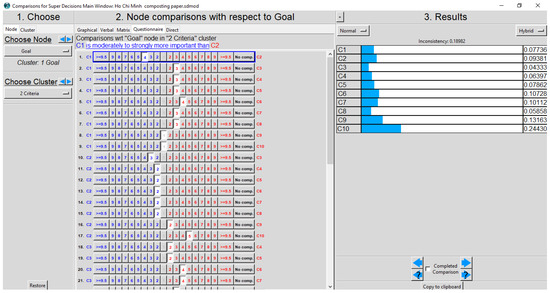
Figure A1.
Node comparisons with respect to Goal.
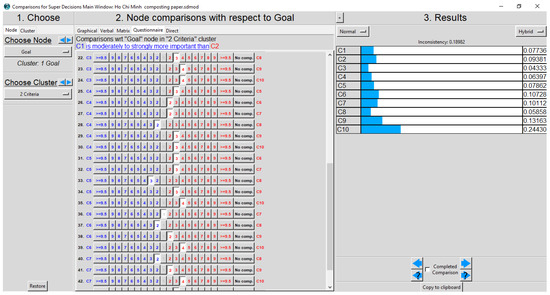
Figure A2.
Node comparisons with respect to Goal.
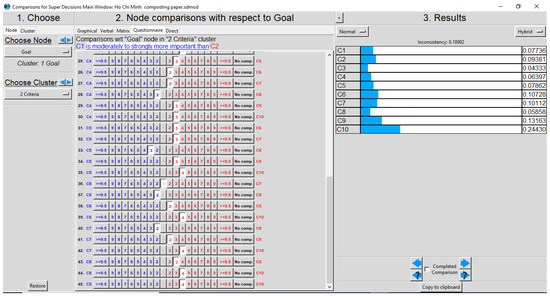
Figure A3.
Node comparisons with respect to Goal.
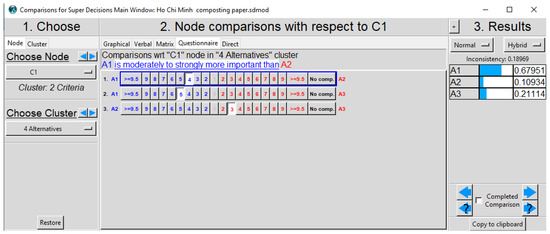
Figure A4.
Node comparisons with respect to C1.
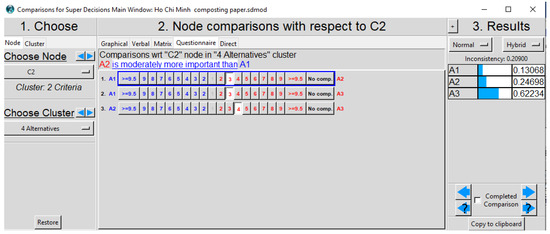
Figure A5.
Node comparisons with respect to C2.
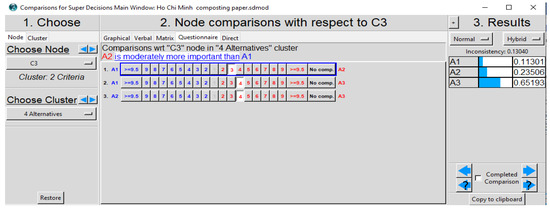
Figure A6.
Node comparisons with respect to C3.
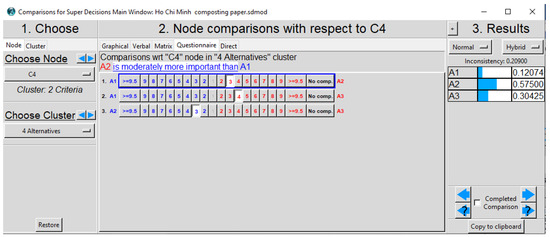
Figure A7.
Node comparisons with respect to C4.
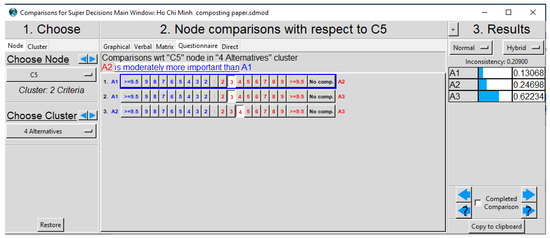
Figure A8.
Node comparisons with respect to C5.
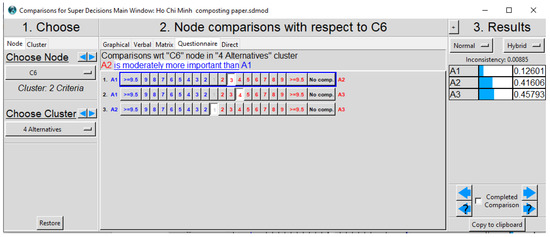
Figure A9.
Node comparisons with respect to C6.
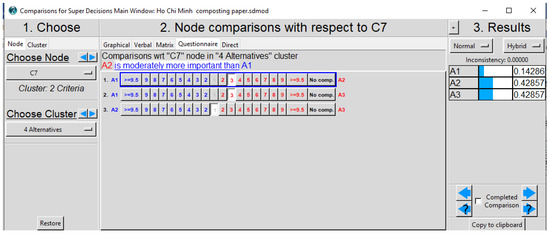
Figure A10.
Node comparisons with respect to C7.
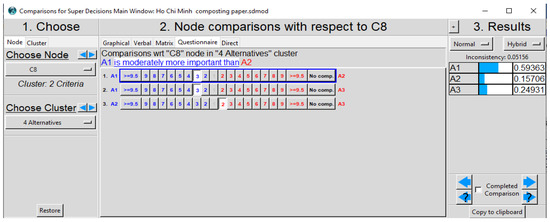
Figure A11.
Node comparisons with respect to C8.
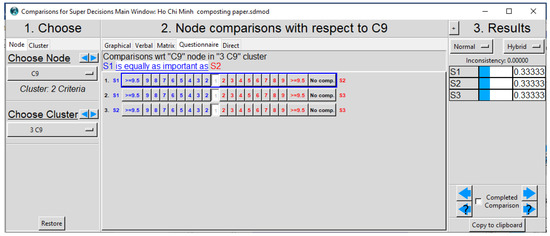
Figure A12.
Node comparisons with respect to C9.
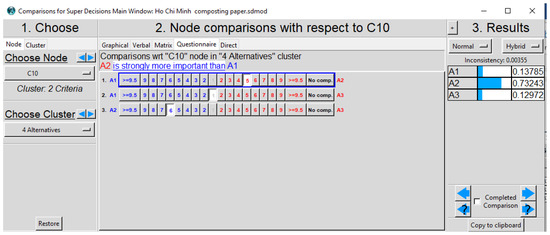
Figure A13.
Node comparisons with respect to C10.
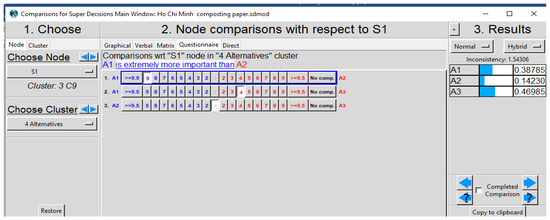
Figure A14.
Node comparisons with respect to S1.
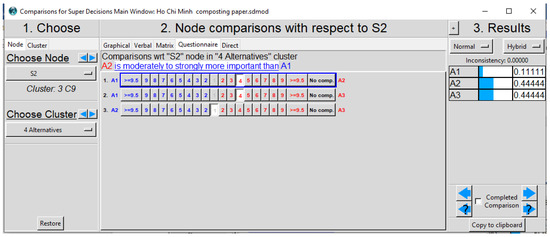
Figure A15.
Node comparisons with respect to S2.
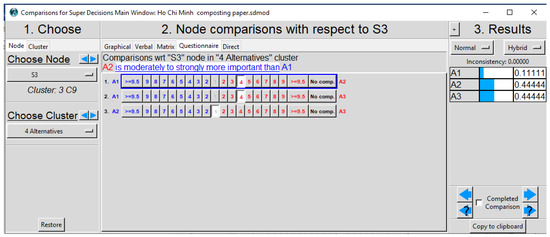
Figure A16.
Node comparisons with respect to S3.
References
- Dhokhikah, Y.; Trihadiningrum, Y. Solid Waste Management in Asian Developing Countries: Challenges and Opportunities. J. Appl. Environ. Biol. Sci. 2012, 2, 329–335. [Google Scholar]
- Rawat, M.; Ramanathan, A.; Kuriakose, T. Characterisation of Municipal Solid Waste Compost (MSWC) from Selected Indian Cities—A Case Study for Its Sustainable Utilisation. JEP 2013, 04, 163–171. [Google Scholar] [CrossRef] [Green Version]
- Toledo, M.; Siles, J.A.; Gutiérrez, M.C.; Martín, M.A. Monitoring of the Composting Process of Different Agroindustrial Waste: Influence of the Operational Variables on the Odorous Impact. Waste Manag. 2018, 76, 266–274. [Google Scholar] [CrossRef] [PubMed]
- Ayilara, M.; Olanrewaju, O.; Babalola, O.; Odeyemi, O. Waste Management through Composting: Challenges and Potentials. Sustainability 2020, 12, 4456. [Google Scholar] [CrossRef]
- Fathi, H. Municipal Solid Waste Characterization and It Is Assessment for Potential Compost Production: A Case Study in Zanjan City, Iran. AJAF 2014, 2, 39. [Google Scholar] [CrossRef] [Green Version]
- Shyamala, D.C.; Belagali, S.L. Studies on Variations in Physico-Chemical and Biological Characteristics at Different Maturity Stages of Municipal Solid Waste Compost. Int. J. Environ. Sci. 2012, 2, 1984–1997. [Google Scholar]
- Cai, Q.-Y.; Mo, C.-H.; Wu, Q.-T.; Zeng, Q.-Y.; Katsoyiannis, A. Concentration and Speciation of Heavy Metals in Six Different Sewage Sludge-Composts. J. Hazard. Mater. 2007, 147, 1063–1072. [Google Scholar] [CrossRef]
- Bai, J.; Shen, H.; Dong, S. Study on Eco-Utilization and Treatments of Highway Greening Waste. Procedia Environ. Sci. 2010, 2, 25–31. [Google Scholar] [CrossRef] [Green Version]
- Yu, H.; Xie, B.; Khan, R.; Shen, G. The Changes in Carbon, Nitrogen Components and Humic Substances during Organic-Inorganic Aerobic Co-Composting. Bioresour. Technol. 2019, 271, 228–235. [Google Scholar] [CrossRef]
- Rama, L.; Vasanthy, M. Market Waste Management Using Compost Technology. Int. J. Plant Anim. Environ. Sci. 2014, 4, 57–61. [Google Scholar]
- Ahmad, R.; Jilani, G.; Arshad, M.; Zahir, Z.A.; Khalid, A. Bio-Conversion of Organic Wastes for Their Recycling in Agriculture: An Overview of Perspectives and Prospects. Ann. Microbiol. 2007, 57, 471–479. [Google Scholar] [CrossRef]
- Kaza, S.; Yao, L.C.; Bhada-Tata, P.; Van Woerden, F. What a Waste 2.0: A Global Snapshot of Solid Waste Management to 2050; Urban Development, World Bank: Washington, DC, USA, 2018. [Google Scholar]
- Luchsinger, G. Shaping the Future: How Changing Demographics Can Power Human Development, Asia-Pacific Human Development Report; Printcraft Company Limited: Dhaka, Bangladesh, 2016. [Google Scholar]
- Laohalidanond, K.; Chaiyawong, P.; Kerdsuwan, S. Municipal Solid Waste Characteristics and Green and Clean Energy Recovery in Asian Megacities. Energy Procedia 2015, 79, 391–396. [Google Scholar] [CrossRef] [Green Version]
- Tv, R.; Aithal, B.H.; Sanna, D.D. Insights to Urban Dynamics through Landscape Spatial Pattern Analysis. Int. J. Appl. Earth Obs. Geoinf. 2012, 18, 329–343. [Google Scholar] [CrossRef]
- Ramachandra, T.V.; Bharath, H.A.; Kulkarni, G.; Han, S.S. Municipal Solid Waste: Generation, Composition and GHG Emissions in Bangalore, India. Renew. Sustain. Energy Rev. 2018, 82, 1122–1136. [Google Scholar] [CrossRef]
- Ramachandra, T.V. Integrated Management of Municipal Solid Waste. In Environmental Security: Human & Animal Health, Chapter 30; IBDC Publishers: Lucknow, India, 2011. [Google Scholar]
- Hoornweg, D.; Bhada-Tata, P. What a Waste: A Global Review of Solid Waste Management; Urban Development Series; Knowledge Papers; World Bank: Washington, DC, USA, 2012. [Google Scholar]
- Aleluia, J.; Ferrão, P. Characterization of Urban Waste Management Practices in Developing Asian Countries: A New Analytical Framework Based on Waste Characteristics and Urban Dimension. Waste Manag. 2016, 58, 415–429. [Google Scholar] [CrossRef] [PubMed]
- Wilson, D.C.; Rodic-Wiersma, L.; Scheinberg, A. Comparative Analysis of Solid Waste Management in Cities around the World; Waste and Resource Management-Putting Strategy into Practice; Stratford-upon-Avon: Warwickshire, UK, 2010. [Google Scholar]
- Wilson, D.C.; Rodic, L.; Scheinberg, A.; Velis, C.A.; Alabaster, G. Comparative Analysis of Solid Waste Management in 20 Cities. Waste Manag. Res. 2012, 30, 237–254. [Google Scholar] [CrossRef] [PubMed] [Green Version]
- Karamouz, M.; Zahraie, B.; Kerachian, R.; Jaafarzadeh, N.; Mahjouri, N. Developing a Master Plan for Hospital Solid Waste Management: A Case Study. Waste Manag. 2007, 27, 626–638. [Google Scholar] [CrossRef] [PubMed]
- Moeinaddini, M.; Khorasani, N.; Danehkar, A.; Darvishsefat, A.A.; Zienalyan, M. Siting MSW Landfill Using Weighted Linear Combination and Analytical Hierarchy Process (AHP) Methodology in GIS Environment (Case Study: Karaj). Waste Manag. 2010, 30, 912–920. [Google Scholar] [CrossRef]
- Thanki, S.; Govindan, K.; Thakkar, J. An Investigation on Lean-Green Implementation Practices in Indian SMEs Using Analytical Hierarchy Process (AHP) Approach. J. Clean. Prod. 2016, 135, 284–298. [Google Scholar] [CrossRef]
- Daneshfar, M.A.; Ardjmand, M. Selecting a Suitable Model for Collecting, Transferring, and Recycling Drilling Wastes Produced in the Operational Areas of the Iranian Offshore Oil Company (IOOC) Using Analytical Hierarchy Process (AHP). J. Environ. Manag. 2020, 259, 109791. [Google Scholar] [CrossRef]
- Ismail, A.R.; Alias, A.H.; Sulaiman, W.R.W.; Jaafar, M.Z.; Ismail, I. Drilling Fluid Waste Management in Drilling for Oil and Gas Wells. Chem. Eng. Trans. 2017, 56, 1351–1356. [Google Scholar] [CrossRef]
- Abdel-Shafy, H.I.; Mansour, M.S.M. Solid Waste Issue: Sources, Composition, Disposal, Recycling, and Valorization. Egypt. J. Pet. 2018, 27, 1275–1290. [Google Scholar] [CrossRef]
- Nixon, J.D.; Dey, P.K.; Ghosh, S.K.; Davies, P.A. Evaluation of Options for Energy Recovery from Municipal Solid Waste in India Using the Hierarchical Analytical Network Process. Energy 2013, 59, 215–223. [Google Scholar] [CrossRef]
- Brent, A.; Rogers, D.; Ramabitsa-Siimane, T.; Rohwer, M.B. Application of the Analytical Hierarchy Process to Establish Health Care Waste Management Systems That Minimise Infection Risks in Developing Countries. Eur. J. Oper. Res. 2007, 181, 403–424. [Google Scholar] [CrossRef] [Green Version]
- Contreras, F.; Hanaki, K.; Aramaki, T.; Connors, S. Application of Analytical Hierarchy Process to Analyze Stakeholders Preferences for Municipal Solid Waste Management Plans, Boston, USA. Resour. Conserv. Recycl. 2008, 52, 979–991. [Google Scholar] [CrossRef]
- Abba, A.H.; Noor, Z.Z.; Yusuf, R.O.; Din, M.F.M.D.; Hassan, M.A.A. Assessing Environmental Impacts of Municipal Solid Waste of Johor by Analytical Hierarchy Process. Resour. Conserv. Recycl. 2013, 73, 188–196. [Google Scholar] [CrossRef]
- Kuo, T.C. Combination of Case-Based Reasoning and Analytical Hierarchy Process for Providing Intelligent Decision Support for Product Recycling Strategies. Expert Syst. Appl. 2010, 37, 5558–5563. [Google Scholar] [CrossRef]
- Kheybari, S.; Rezaie, F.M.; Naji, S.A.; Najafi, F. Evaluation of Energy Production Technologies from Biomass Using Analytical Hierarchy Process: The Case of Iran. J. Clean. Prod. 2019, 232, 257–265. [Google Scholar] [CrossRef]
- Khodaparast, M.; Rajabi, A.M.; Edalat, A. Municipal Solid Waste Landfill Siting by Using GIS and Analytical Hierarchy Process (AHP): A Case Study in Qom City, Iran. Environ. Earth Sci. 2018, 77, 52. [Google Scholar] [CrossRef]
- Abessi, O.; Saeedi, M. Hazardous Waste Landfill Siting Using GIS Technique and Analytical Hierarchy Process. Environ. Asia 2010, 3, 47–53. [Google Scholar] [CrossRef]
- Chabuk, A.; Al-Ansari, N.; Hussain, H.M.; Knutsson, S.; Pusch, R. Landfill Site Selection Using Geographic Information System and Analytical Hierarchy Process: A Case Study Al-Hillah Qadhaa, Babylon, Iraq. Waste Manag. Res. 2016, 34, 427–437. [Google Scholar] [CrossRef] [PubMed]
- Khoshand, A.; Kamalan, H.; Rezaei, H. Application of Analytical Hierarchy Process (AHP) to Assess Options of Energy Recovery from Municipal Solid Waste: A Case Study in Tehran, Iran. J. Mater. Cycles Waste Manag. 2018, 20, 1689–1700. [Google Scholar] [CrossRef]
- Li, Z.; Zhao, F. An Analytical Hierarchy Process-Based Study on the Factors Affecting Legislation on Plastic Bags in the USA. Waste Manag. Res. 2017, 35, 795–809. [Google Scholar] [CrossRef] [PubMed]
- Pun, K.F.; Hui, I.K. An Analytical Hierarchy Process Assessment of the ISO 14001 Environmental Management System. Integr. Mfg Syst. 2001, 12, 333–345. [Google Scholar] [CrossRef]
- Qdais, H.A.; Alshraideh, H. Selection of Management Option for Solid Waste from Olive Oil Industry Using the Analytical Hierarchy Process. J. Mater. Cycles Waste Manag. 2016, 18, 177–185. [Google Scholar] [CrossRef]
- Osra, F.A.; Kajjumba, G.W. Landfill Site Selection in Makkah Using Geographic Information System and Analytical Hierarchy Process. Waste Manag. Res. 2020, 38, 245–253. [Google Scholar] [CrossRef]
- Sodhi, H.S.; Singh, D.; Singh, B.J. An Investigation of Barriers to Waste Management Techniques Implemented in Indian Manufacturing Industries Using Analytical Hierarchy Process. WJSTSD 2020, 17, 58–70. [Google Scholar] [CrossRef]
- Otto-Zimmermann, K. Resilient Cities: Cities and Adaptation to Climate Change-Proceedings of the Global Forum 2010; Springer Science & Business Media: Berlin/Heidelberg, Germany, 2011. [Google Scholar]
- GSOVN. Population and Employment; GSOVN (General Statistics Office of Vietnam): Hanoi, Vietnam, 2020.
- HCMC DONRE. Report on Solid Waste Management in Ho Chi Minh City; Ho Chi Minh City Department of Natural Resources and Environment (HCMC DONRE): Ho Chi Minh City, Vietnam, 2014.
- ThiKimOanh, L.; Bloemhof-Ruwaard, J.M.; van Buuren, J.C.; van der Vorst, J.G.; Rulkens, W.H. Modelling and Evaluating Municipal Solid Waste Management Strategies in a Mega-City: The Case of Ho Chi Minh City. Waste Manag. Res. 2015, 33, 370–380. [Google Scholar] [CrossRef]
- Verma, R.L.; Borongan, G.; Memon, M. Municipal Solid Waste Management in Ho Chi Minh City, Viet Nam, Current Practices and Future Recommendation. Procedia Environ. Sci. 2016, 35, 127–139. [Google Scholar] [CrossRef]
- Nguyen, T. Solid Waste Separation at Source: Necessary and Sufficient Condition for Waste Management in Ho Chi Minh. Van Lang University I. Int. J. Environ. Sci. Sustain. Dev. 2012, 1, 1–9. [Google Scholar]
- Schneider, P.; Anh, L.; Wagner, J.; Reichenbach, J.; Hebner, A. Solid Waste Management in Ho Chi Minh City, Vietnam: Moving towards a Circular Economy? Sustainability 2017, 9, 286. [Google Scholar] [CrossRef] [Green Version]
- Saaty, T.L. How to Make a Decision: The Analytic Hierarchy Process. Interfaces. JSTOR 1994, 24, 19–43. [Google Scholar]
- Saaty, T.L. Fundamentals of the Analytic Hierarchy Process. In The Analytic Hierarchy Process in Natural Resource and Environmental Decision Making; Schmoldt, D.L., Kangas, J., Mendoza, G.A., Pesonen, M., Eds.; Managing Forest Ecosystems; Springer: Dordrecht, The Netherlands, 2001; Volume 3, pp. 15–35. ISBN 978-90-481-5735-8. [Google Scholar]
- Saaty, T.L. Theory and Applications of the Analytic Network Process: Decision Making with Benefits, Opportunities, Costs, and Risks; RWS Publications: Pittsburgh, PA, USA, 2005. [Google Scholar]
- Saaty, T.L. Decision Making with the Analytic Hierarchy Process. Int. J. Serv. Sci. 2008, 1, 83–98. [Google Scholar] [CrossRef] [Green Version]
- Saaty, T.L.; Vargas, L.G. The Seven Pillars of the Analytic Hierarchy Process. In Models, Methods, Concepts & Applications of the Analytic Hierarchy Process; International Series in Operations Research & Management Science; Springer: Boston, MA, USA, 2012; Volume 175, pp. 23–40. ISBN 978-1-4614-3596-9. [Google Scholar]
- Bertolini, M.; Braglia, M.; Carmignani, G. Application of the AHP Methodology in Making a Proposal for a Public Work Contract. Int. J. Proj. Manag. 2006, 24, 422–430. [Google Scholar] [CrossRef]
- Sipahi, S.; Timor, M. The Analytic Hierarchy Process and Analytic Network Process: An Overview of Applications. Manag. Decis. 2010, 48, 775–808. [Google Scholar] [CrossRef]
- Vučijak, B.; Kurtagić, S.M.; Silajdžić, I. Multicriteria Decision Making in Selecting Best Solid Waste Management Scenario: A Municipal Case Study from Bosnia and Herzegovina. J. Clean. Prod. 2016, 130, 166–174. [Google Scholar] [CrossRef]
- Jovanovic, S.; Savic, S.; Jovicic, N.; Boskovic, G.; Djordjevic, Z. Using Multi-Criteria Decision Making for Selection of the Optimal Strategy for Municipal Solid Waste Management. Waste Manag Res 2016, 34, 884–895. [Google Scholar] [CrossRef] [PubMed]
- Su, J.-P.; Chiueh, P.-T.; Hung, M.-L.; Ma, H.-W. Analyzing Policy Impact Potential for Municipal Solid Waste Management Decision-Making: A Case Study of Taiwan. Resour. Conserv. Recycl. 2007, 51, 418–434. [Google Scholar] [CrossRef]
- Herva, M.; Roca, E. Ranking Municipal Solid Waste Treatment Alternatives Based on Ecological Footprint and Multi-Criteria Analysis. Ecol. Indic. 2013, 25, 77–84. [Google Scholar] [CrossRef]
- Morrissey, A.J.; Browne, J. Waste Management Models and Their Application to Sustainable Waste Management. Waste Manag. 2004, 24, 297–308. [Google Scholar] [CrossRef]
- Jara-Samaniego, J.; Pérez-Murcia, M.D.; Bustamante, M.A.; Paredes, C.; Pérez-Espinosa, A.; Gavilanes-Terán, I.; López, M.; Marhuenda-Egea, F.C.; Brito, H.; Moral, R. Development of Organic Fertilizers from Food Market Waste and Urban Gardening by Composting in Ecuador. PLoS ONE 2017, 12, e0181621. [Google Scholar] [CrossRef] [PubMed] [Green Version]
- Behrooznia, L.; Sharifi, M.; Hosseinzadeh-Bandbafha, H. Comparative Life Cycle Environmental Impacts of Two Scenarios for Managing an Organic Fraction of Municipal Solid Waste in Rasht-Iran. J. Clean. Prod. 2020, 268, 122217. [Google Scholar] [CrossRef]
- Di Nola, M.F.; Escapa, M.; Ansah, J.P. Modelling Solid Waste Management Solutions: The Case of Campania, Italy. Waste Manag. 2018, 78, 717–729. [Google Scholar] [CrossRef] [PubMed]
- Shekdar, A.V. Sustainable Solid Waste Management: An Integrated Approach for Asian Countries. Waste Manag. 2009, 29, 1438–1448. [Google Scholar] [CrossRef]
- Guerrero, L.A.; Maas, G.; Hogland, W. Solid Waste Management Challenges for Cities in Developing Countries. Waste Manag. 2013, 33, 220–232. [Google Scholar] [CrossRef]
- Hoang, N.H.; Fogarassy, C. Sustainability Evaluation of Municipal Solid Waste Management System for Hanoi (Vietnam)—Why to Choose the ‘Waste-to-Energy’ Concept. Sustainability 2020, 12, 1085. [Google Scholar] [CrossRef] [Green Version]
- Arafat, H.A.; Jijakli, K.; Ahsan, A. Environmental Performance and Energy Recovery Potential of Five Processes for Municipal Solid Waste Treatment. J. Clean. Prod. 2015, 105, 233–240. [Google Scholar] [CrossRef]
- Cimpan, C.; Wenzel, H. Energy Implications of Mechanical and Mechanical–Biological Treatment Compared to Direct Waste-to-Energy. Waste Manag. 2013, 33, 1648–1658. [Google Scholar] [CrossRef]
- Kumar, A.; Samadder, S.R. A Review on Technological Options of Waste to Energy for Effective Management of Municipal Solid Waste. Waste Manag. 2017, 69, 407–422. [Google Scholar] [CrossRef]
- Makarichi, L.; Jutidamrongphan, W.; Techato, K. The Evolution of Waste-to-Energy Incineration: A Review. Renew. Sustain. Energy Rev. 2018, 91, 812–821. [Google Scholar] [CrossRef]
- Baxter, J.; Ho, Y.; Rollins, Y.; Maclaren, V. Attitudes toward Waste to Energy Facilities and Impacts on Diversion in Ontario, Canada. Waste Manag. 2016, 50, 75–85. [Google Scholar] [CrossRef] [PubMed]
- Fei, F.; Wen, Z.; Huang, S.; De Clercq, D. Mechanical Biological Treatment of Municipal Solid Waste: Energy Efficiency, Environmental Impact and Economic Feasibility Analysis. J. Clean. Prod. 2018, 178, 731–739. [Google Scholar] [CrossRef]
- Prajapati, P.; Varjani, S.; Singhania, R.R.; Patel, A.K.; Awasthi, M.K.; Sindhu, R.; Zhang, Z.; Binod, P.; Awasthi, S.K.; Chaturvedi, P. Critical Review on Technological Advancements for Effective Waste Management of Municipal Solid Waste — Updates and Way Forward. Environ. Technol. Innov. 2021, 23, 101749. [Google Scholar] [CrossRef]
- Temeljotov Salaj, A.; Lindkvist, C.M. Urban Facility Management. Facilities 2021, 39, 525–537. [Google Scholar] [CrossRef]
- Babalola, M.A. A Multi-Criteria Decision Analysis of Waste Treatment Options for Food and Biodegradable Waste Management in Japan. Environments 2015, 2, 471–488. [Google Scholar] [CrossRef] [Green Version]
- Machado, C.R.; Hettiarachchi, H. Composting as a Municipal Solid Waste Management Strategy: Lessons Learned from Cajicá, Colombia. In Organic Waste Composting through Nexus Thinking; Hettiarachchi, H., Caucci, S., Schwärzel, K., Eds.; Springer International Publishing: Cham, Switzerland, 2020; pp. 17–38. ISBN 978-3-030-36282-9. [Google Scholar]
Publisher’s Note: MDPI stays neutral with regard to jurisdictional claims in published maps and institutional affiliations. |
© 2022 by the authors. Licensee MDPI, Basel, Switzerland. This article is an open access article distributed under the terms and conditions of the Creative Commons Attribution (CC BY) license (https://creativecommons.org/licenses/by/4.0/).